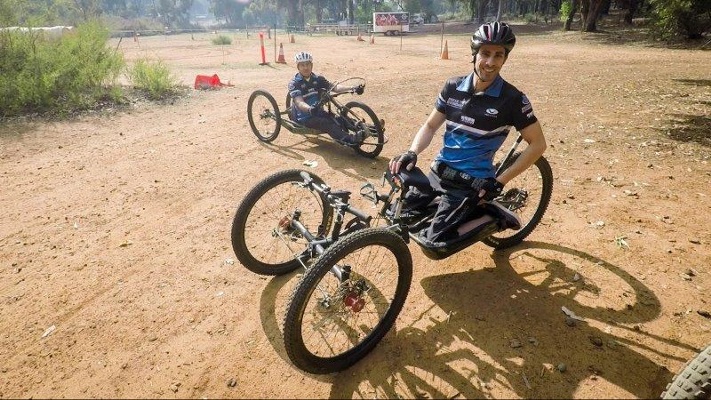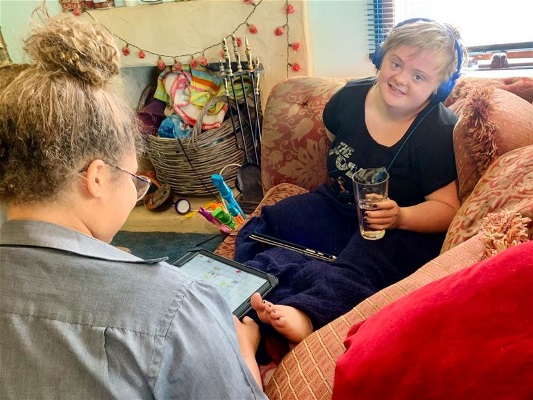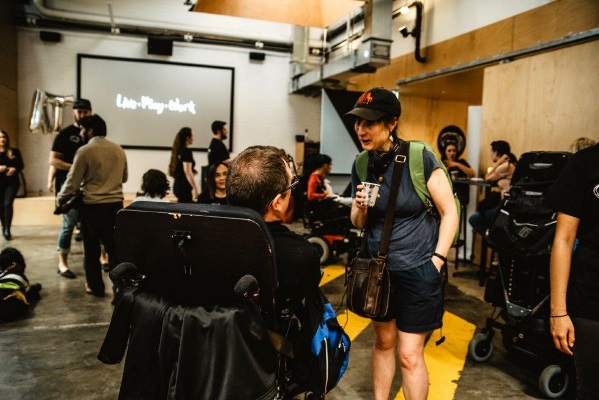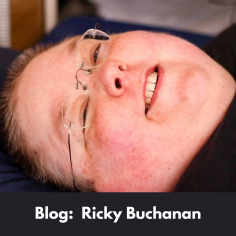
AT Chat interviews and explores the benefits, process and barriers to customising assistive technology (AT) with expert AT user Ricky Buchanan.
Ricky has been customising AT for many years including adapting a drumstick and an over the head mounted computer screen.
Can you tell us why you have customised so much AT? What’s the advantages it’s offered?
For me, the most obvious answer is that my disability causes a lot of pain and fatigue and I’m bedridden. Those are things that we don’t have a lot of established AT solutions for. I think a lot of our AT solutions are for people with disabilities such as paralysis or cerebral palsy or disabilities which are well known. Solutions for people who live with pain and fatigue and people who are bedridden are less well established in the AT world.
I also think it’s just the way my brain works. Recently I was reading through some journals recently that I kept when I was about 12, and even though my first experience of disability wasn’t really until I was 14 I had already carefully figured out how to use some pulleys, string and some Lego and a rock to automate or make a switch that would allow me to turn my bedroom light on and off while I was lying on the top bunk without getting up.
I think perhaps my brain is just designed to want to make my environment as optimal as possible and because I happened to end up with a disability where that’s really really useful; I’ve had the opportunity to practice a lot over the last 20 something years.
What is the process that you use and what are the benefits of using it?
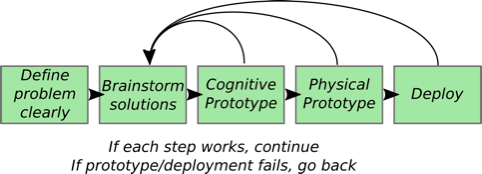
Alt Text for image above: Five rectangles side by side with arrow pointing to and connecting each one. Wording in each square from left to right says, define problem clearly, brainstorm solutions, cognitive prototype, physical prototype, deploy. Wording underneath says If each step works, continue, if prototype/deployment fails, go back. There is an arrow from each of the last three rectangles that point back to the second rectangle.
I use a modified waterfall design process when I’m customising AT. It goes through each step from defining the problem clearly, brainstorming solutions, making up a prototype of a solution in my head and trying to imagine using it. It allows you to imagine how it will work and to see if you can figure out what’s wrong with it and solve as many problems as possible before making it; I call that a cognitive prototype.
The next step is making a physical prototype, an actual model, and then we go back and change the model if it doesn’t work. It never works, or very infrequently works exactly as you thought it would. Then if needed we make a final version. If any of those steps don’t work, do them again, so you can just keep going back and forward until you finally get to the end with solution that you like and works for you.
I think it helps to have a formalised way of doing it because it reminds you of all the steps. If you start without clearly figuring out what the problem is that you’re trying to solve, your pretty much destined to get the end being really upset because you haven’t solved the problem properly. Or if you skipped around and don’t think of all the different ways you could solve the problem and you just think of one way, then you’ll probably won’t have the best solution when you come to the end. I think it saves energy in the long run to have a formalised process because it reminds you to go through all the important steps.
What are some of the pitfalls and/or barriers to customising AT?
I think the biggest problem is that people just don’t really think of doing it. Especially if you have a disability where there are established solutions to a problem. You get people telling you, this is the best thing, this is thing you need to solve this problem that you’re having. It’s pretty infrequent to come across an occupational therapist or a person that encourages you to really think about the options and to think about customising AT.
What would the world be like if we offered peer-supported classes in imagining an ideal AT solution for yourself and learning how to customise it. Or learning how to direct other people to customise it for you; wouldn’t that be fantastic. I think that would make the world a better place.
What risks are involved?
If you have a problem, and there’s an established AT solution to that problem, it’s probably going to work; at least kind of more or less OK. It might not be perfect, it might not be ideal; it almost certainly won’t be ideal, but it will do an OK job.
If you try and invent something new, it might be fantastic, it might be brilliant, and the best possible solution if you’re really lucky. You also run the risk that your solution might just not work at all, might cost you a lot of money and you might spend a lot of energy and time and end up with literally nothing to show for it.
Hopefully when people start customising AT they’ll start with smaller simpler things and not jump right into and try to build a new wheelchair for example.
I think another high risk when trying to customise AT is that you have to be able and willing to deal with failure. I also think some people might have a problem making the prototype solution. If you are not able to build the item yourself or you’re not able to communicate to others what you want them to make, or the people that are helping you just aren’t able to make the item, then customising your own AT can fail.
It’s taken me a really long time to build a team of people around me who are both willing and able to build crazy things for me. It’s been really worthwhile searching for those people, but it’s very frustrating when I get to the part where I have a really good idea, but I can’t build it because I don’t have the people that I need to support me to build it.
Can you tell us about a simple piece of AT that you have customised?
 One of my favourite really simple pieces of AT that I’ve customised is actually a drum-stick. If you can imagine the sort of drumstick that people use for a really big low sounding base drum. It’s like a long wooden stick with a round piece of quite soft material on the end.
One of my favourite really simple pieces of AT that I’ve customised is actually a drum-stick. If you can imagine the sort of drumstick that people use for a really big low sounding base drum. It’s like a long wooden stick with a round piece of quite soft material on the end.
I needed something that would allow me to move my computer screen around. I can’t reach it with my fingers as it’s over my head and often during the day I need to turn the screen to the side so other people can look at it with me. I also need the drum-stick to always be somewhere that I can reach because I’m bedridden. There aren’t a lot of places that I can reach and there is a lot of stuff that I want and need to keep within arm’s reach so space that is within my arms reach is kind of at a premium.
I was trying to figure out a place that I could keep the drum-stick so it would always be where I could reach it, and it wouldn’t fall down and it wouldn’t get lost and so I got a piece of Sugru. Sugru is like plasticine or mouldable glue that sets. I made a hook on the side of a drumstick, and now it hooks over the bedhead that I lie in all day. It’s always very close to my fingers and it’s not in the way and it’s a very successful a piece of AT. I also get the great amusement of being able to tell people that one of my most precious pieces of AT is a drumstick which always makes them laugh which is so awesome.
Can you tell us about a more complex piece of AT you have customised?
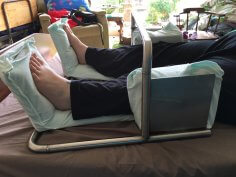 One of my favourite really complex pieces of AT that I’ve customised is a leg splint; we call it the scaffolding. If you imagine the scaffolding on a building when a really old building is being renovated and they put a metal structure around it to hold the building up while they’re fixing it. That’s what my leg scaffolding does. It’s a metal kind of cage and my legs fit inside it and it holds my ankles and my knees and hips in a really good position so that my pain is minimised, and my calf muscles don’t shrink and everything is in the best position possible.
One of my favourite really complex pieces of AT that I’ve customised is a leg splint; we call it the scaffolding. If you imagine the scaffolding on a building when a really old building is being renovated and they put a metal structure around it to hold the building up while they’re fixing it. That’s what my leg scaffolding does. It’s a metal kind of cage and my legs fit inside it and it holds my ankles and my knees and hips in a really good position so that my pain is minimised, and my calf muscles don’t shrink and everything is in the best position possible.
This item does not exist as an off-the-shelf piece of AT that you can buy; all of the existing solutions for holding people’s legs in place had really big problems that meant I couldn’t use them. Generally, they needed someone else to put them on and off, because I think most people that need these type of leg splints are also not able to independently get out of bed whereas I can.
When I need to get out of bed in the middle of the night without a support worker, I needed to be able to put it on and off and position it myself. If I move a few inches up or down the bed, I have to move the leg splint, so it is in the right spot.
It took many years of the designing and finding a guy who is able to do the welding. I used 3D modelling software to draw what I needed and measure all the angles and everything and eventually I asked the person to weld it for me and thank heavens it was fantastic, and it’s been just perfect. It’s been very very very useful and helps an enormous amount with my pain and was super successful.
I was fairly sure it would work even though it was definitely very complicated and a bit scary. I had to pay $1,500 to have all of it made so if I had made a mistake, it would have been a really expensive mistake, so thank goodness it worked.
What is your favourite piece of AT and why?
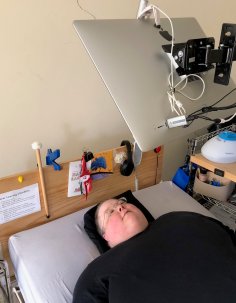 My computer screen mount is my favourite piece of AT because it makes my life so much better because I’m bedridden. If you can imagine I’ve got a hospital bed in my living room, and I lie on my back, so I’m staring at the ceiling. I’m not able to sit the head end of the bed up anymore. So, I’m just flat and I needed something that would hold the computer screen so it’s hanging in space over my head.
My computer screen mount is my favourite piece of AT because it makes my life so much better because I’m bedridden. If you can imagine I’ve got a hospital bed in my living room, and I lie on my back, so I’m staring at the ceiling. I’m not able to sit the head end of the bed up anymore. So, I’m just flat and I needed something that would hold the computer screen so it’s hanging in space over my head.
No one makes anything that does that, so I designed a computer screen mount. The bottom part of it looks a bit like those tables with wheels that they have over hospital beds. At the top, there’s a bar that comes across above my head. I have put a commercial mount, the sort that’s used to attach a flat screen TV to the wall and put that on the horizontal bar part of the mount so I can adjust the angle of the computer screen.
It works fantastically and looks really smart. I wish that they were commercially available, because there’s lots of people who are bedridden, and I think everyone who needs access to a computer should be able to get it at a price that they can afford.
Is there a product that someone new to customising their own AT could easily us?
I think that’s Sugru, which I mentioned before or another product called plastimake, which is similar. It’s kind of like plastic that you can melt in hot water. It’s a really great product for those are starting to customise things. You can use them to make a hook that you can attach to your wheelchair, bed, the wall or set of shelves for example. You can use them to build up a handle, like a pen or a hairbrush to make it easier for you to hold or you can put a little blob of it on a switch like a light switch or a zipper to make things easier to grab.
There’s a lot of really easy little bits of customising that you can do and I always tell people that they are like the Gateway Drug of AT customisation.
What would you say to someone who is considering customising a piece of AT (where to start, what are some considerations)?
First thing I always do when I’m customising a piece of AT is to think a lot. I think about it consciously, but I also put the problem on the backburner of my brain and tell my brain to think about it when I’m resting. Because I’m bedridden, there’s a lot of hours of the day where I’m not doing anything except staring at the ceiling so that give me lots of time to think about customising things and come up with different possible solutions.
When I’ve done lots of thinking the next thing I do is talk to people who know what my needs are or other people with disabilities who have similar needs. I say hey, this is what I’ve been thinking of, what do you think about it? Lots of times they can tell me if part of what I thought they think won’t work or they think it’s great. That way my idea gets a lot better before I’m at the stage of having the item made. You can’t go wrong if you’re just thinking about something. You won’t make any unfortunate mistakes and if you do it’s easy to fix them as they’re just at the imagining stage.
What’s next on your AT list to customise?
On my night bed, which is a queen-size bed, I have a couple of wire baskets that sit up in the corners beside my head on the left and right, but far enough away that I don’t whack into them.
The one on one side is fantastic, it has my bedside table to lean against but the one on the other side is just sitting on the end of the bed and about once a month it ends up on the floor because I was moving around too much. I figured out if I get a l-shape piece of metal like those book-ends they have in libraries, and I put it under the mattress, and it can pokes up just enough to stop the basket falling out of bed, that might work. So, that’s what I’m planning to customise next.
After that who knows, my brain likes coming up with different ways to adapt things.


 One of my favourite really simple pieces of AT that I’ve customised is actually a drum-stick. If you can imagine the sort of drumstick that people use for a really big low sounding base drum. It’s like a long wooden stick with a round piece of quite soft material on the end.
One of my favourite really simple pieces of AT that I’ve customised is actually a drum-stick. If you can imagine the sort of drumstick that people use for a really big low sounding base drum. It’s like a long wooden stick with a round piece of quite soft material on the end.  One of my favourite really complex pieces of AT that I’ve customised is a leg splint; we call it the scaffolding. If you imagine the scaffolding on a building when a really old building is being renovated and they put a metal structure around it to hold the building up while they’re fixing it. That’s what my leg scaffolding does. It’s a metal kind of cage and my legs fit inside it and it holds my ankles and my knees and hips in a really good position so that my pain is minimised, and my calf muscles don’t shrink and everything is in the best position possible.
One of my favourite really complex pieces of AT that I’ve customised is a leg splint; we call it the scaffolding. If you imagine the scaffolding on a building when a really old building is being renovated and they put a metal structure around it to hold the building up while they’re fixing it. That’s what my leg scaffolding does. It’s a metal kind of cage and my legs fit inside it and it holds my ankles and my knees and hips in a really good position so that my pain is minimised, and my calf muscles don’t shrink and everything is in the best position possible.  My computer screen mount is my favourite piece of AT because it makes my life so much better because I’m bedridden. If you can imagine I’ve got a hospital bed in my living room, and I lie on my back, so I’m staring at the ceiling. I’m not able to sit the head end of the bed up anymore. So, I’m just flat and I needed something that would hold the computer screen so it’s hanging in space over my head.
My computer screen mount is my favourite piece of AT because it makes my life so much better because I’m bedridden. If you can imagine I’ve got a hospital bed in my living room, and I lie on my back, so I’m staring at the ceiling. I’m not able to sit the head end of the bed up anymore. So, I’m just flat and I needed something that would hold the computer screen so it’s hanging in space over my head. 
